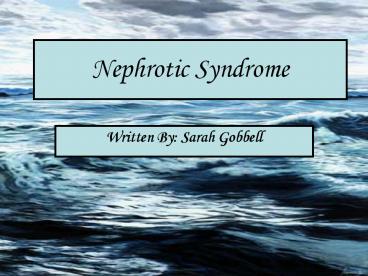Nephrotic Syndrome - PowerPoint PPT Presentation
Title:
Nephrotic Syndrome
Description:
Nephrotic Syndrome Written By: Sarah Gobbell Etiology/ Pathophysiology Syndrome- a complex of signs and symptoms resulting from a common cause. Damaged glomeruli as a ... – PowerPoint PPT presentation
Number of Views:1130
Avg rating:3.0/5.0
Title: Nephrotic Syndrome
1
Nephrotic Syndrome
- Written By Sarah Gobbell
2
Etiology/ Pathophysiology
- Syndrome- a complex of signs and symptoms
resulting from a common cause. - Damaged glomeruli as a result of certain diseases
cause proteins to perfuse into the urine - Characterized by marked proteinuria (protein in
urine), hypoalbuminemia (loss of serum protein),
edema (caused by decreased osmotic pressure).
3
(No Transcript)
4
Clinical Manifestations
- General edema, mainly located around the eyes and
extremities especially around the feet and
ankles. - Swollen abdomen/ facial swelling
- Foamy appearance of urine
- Unintentional weight gain
- Poor appetite
- High blood pressure
- Decreased urine output
5
Labs/ Diagnostics
- Blood chemistry shows hypoalbuminemia and
hyperlipidemia- Urinalysis reveals urine protein - Renal biopsy identifies type and extent of tissue
change - Other Tests to Rule Out Cause
- Glucose tolerance test -- Complement levels
- Antinuclear antibody -- Hepatitis B/C
antibodies - Rheumatoid factor --VDRL serology
- Cryoglobulins -- Serum protein electrophoresis
6
Renal Biopsy
Glucose Tolerance Test
Blood Chemistry Test
Urinalysis
Cryoglobulins
VDRL Serology
7
Medical Management
- Treatment may be required for life
- Corticosteroids, immunosuppressive,
antihypertensive, and diuretic medications - Antibiotics are used to control infection
- Angiotensin converting enzyme (ACE) inhibitors
may reduce degree of protein loss in the urine - Medications to reduce cholesterol and
triglycerides may be recommended
8
Nursing Interventions
- Monitor I O, weight, measure abdominal girth, BP
- Bed rest if pt has extreme edema
- Assess for electrolyte imbalance
- Skin care/ gradual increase of
- activity as edema resolves
- Diet- protein replacement with foods that provide
high biologic value ( meat, fish, poultry,
cheese, eggs) - Sodium restriction
9
Patient Teaching
- Medication regimen- type, dosage, side effects,
the need to take meds as prescribed - Nutrition- high protein, low sodium
- Self-assessment of fluid status- monitor weight,
presence of edema - Signs/ symptoms indicating need for medical
attention (edema, fatigue, headache, infection) - Need for follow-up care
10
Prognosis
- 25 of children and 50-75 of adults will
progress to renal failure within 5 years - May be remission or nephrotic syndrome will exist
in chronic form - Besides treating the underlying problem, little
can be done to prevent recurrence of nephrotic
syndrome (permanent!)
11
The End































